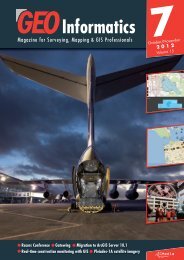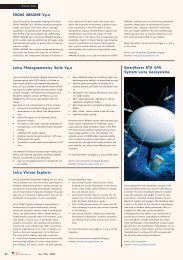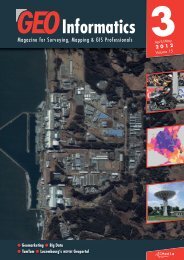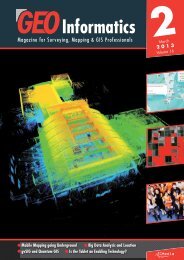2013 - Geoinformatics
2013 - Geoinformatics
2013 - Geoinformatics
You also want an ePaper? Increase the reach of your titles
YUMPU automatically turns print PDFs into web optimized ePapers that Google loves.
36<br />
A r t i c l e<br />
WPS, server-side scripting and the others available in<br />
OpenGeo Suite 3.0 enable you to break free of the<br />
traditional notion that spatial data must be routed<br />
through a specialized GIS workflow<br />
GLOBE system<br />
By chaining the interpolation process to the color ramp process, or<br />
the interpolation process to the contouring process, the GLOBE could<br />
generate attractive outputs that were calculated in real time, so a<br />
contour map for the world or any smaller region could be generated<br />
for any day that the GLOBE system had data (over a decade’s<br />
worth!).<br />
Because the GLOBE solution was WPS chaining inside GeoServer it<br />
could take advantage of existing facilities to:<br />
• Read the data out of the database-agnostic backend.<br />
• Convert the value grid into a color grid with existing styling mechanisms.<br />
• Convert the grid into contours with an existing contouring WPS.<br />
So the only net new code required was the interpolation WPS. This<br />
code would read data from any GeoServer data source (files,<br />
databases, remote WFS services) and build an interpolated grid<br />
using the Barnes interpolation scheme. The results are both attractive<br />
and impressively fast. In addition to the interpolation process,<br />
the OpenGeo Suite 3.0 ships with a WPS for heat map generation.<br />
It works the same way as the interpolation WPS, reading from any<br />
data source, and building a value grid that can then be arbitrarily<br />
colored using the standard GeoServer styling system.<br />
The GLOBE example shows the power of chaining processes together,<br />
particularly as the library of available processes grows over time.<br />
For upcoming releases of the OpenGeo Suite, additional user interfaces<br />
to chain processes visually, as well as clustering capabilities,<br />
will be added. This ensures that high loads will be easily distributed<br />
between multiple back-end servers.<br />
General adoption of open source geospatial and in<br />
particular the OpenGeo Suite is being driven by organizations<br />
like TriMet, USGS and GLOBE, which require<br />
a stable, enterprise ready platform on which to build<br />
innovative applications. The transparency of the open<br />
source code base and the speed with which fixes and<br />
changes can be added, allow organizations building<br />
new systems to get beyond the usual routine of working<br />
around limitations and waiting for upcoming<br />
releases.<br />
For the organizations who are wondering, “where will we get support<br />
for this software?” and “who is going to fix my bugs?” we also<br />
have a ready answer: OpenGeo. Commercial open source providers<br />
fill in the gaps between the raw code available from the open source<br />
community and the enterprise needs of customers. Until recently, a<br />
closed source provider has dominated geospatial web services, but<br />
increasingly open source alternatives have been closing the gap.<br />
Companies like RedHat and OpenGeo provide an enterprise face<br />
and offer a reliable partner to work with on issues from feature development<br />
to security enhancements. This cuts software development<br />
costs and gives customers a chance to share and optimize resources<br />
by working with an expert to steer the software development<br />
roadmap. The OpenGeo Suite 3.0 provides enterprises with superior<br />
value in delivering geospatial web services, whilst simultaneously<br />
increasing the reach and functionality of enterprise systems and controlling<br />
costs.<br />
Paul Ramsey, GeoSpatial Architect, OpenGeo<br />
David Dubovsky, Marketing Manager, OpenGeo<br />
URLs<br />
http://trimet.org/ - Portland TriMet’s website<br />
http://opengeo.org/products/suite/ - The OpenGeo Suite<br />
http://blog.opengeo.org/2012/10/03/opengeo-suite-3-0-released/ - OpenGeo Suite 3.0 details<br />
http://opengeo.org/publications/commercialopensource/ - Commercial Open Source Whitepaper<br />
All of these processes occur on the server, which in effect, designates<br />
the server as the place where new processes are defined.<br />
Although this is not a new idea, this is a major deviation from the<br />
status quo. Additionally, the combination of WPS and server-side<br />
scripting allows developers to create processes that perform complex<br />
analysis (like those previously mentioned) or any other processes<br />
a developer may write. All this is possible using familiar scripting<br />
languages like Python and JavaScript. Together these features enable<br />
IT professionals to build web applications that can run spatial processes<br />
against data in real time, from anywhere, using straightforward<br />
web development practices. This is especially exciting for those<br />
who recognize that spatial data has become just one aspect of the<br />
increasingly complex information technology ecosystem. Tools like<br />
June <strong>2013</strong>










